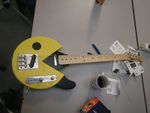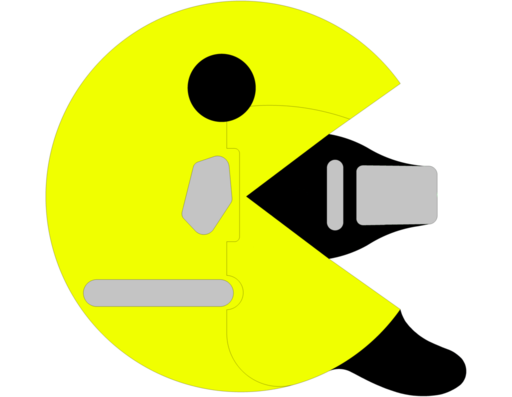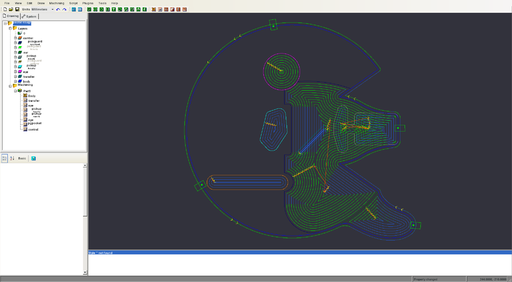PacmanCaster
| PacmanCaster | |

| |
| Gestartet: | 23.5.2018 |
| Involvierte: | User:amir |
| Status: | in progress |
| Beschreibung: | Building a DIY e-guitar in PacMan style |
| Shutdownprozedur: | |
| Zuletzt aktualisiert: | 2018-11-21 |
WTF
This project page is about building a DIY electric guitar in PacMan style. Pickup-, control- and neck design are copied from a Telecaster guitar.
We are going to use the CNC mill to create the body.
This page is about the e-guitar i built. :)
Images Speak Louder Than Words
But videos are clearly louder
That is a video of the pacmancaster before adjusting neck, bridge and pickups. Let's see if i can get it right on my own. Stay tuned.
The following previews are out of date but i guess you get the idea. Check out the image and video above
Design Preview
CAM Preview
Lessions learned
The following "lessions learned" reflect my current level of knowledge which might be not very high :)
- It seems like if the neck is good, the bridge in alignment and the body follows some simple rules - you get a good guitar.
- the body design has to adhere to following rules for a good sound:
- If you do a solid body design avoid large cavities, especially under the pick guard.
- Avoid destabilizing the body in the neck axis.
- You can tune the guitars resonance frequency by removing material (but how much depends on where you remove material. Removing material inline with the neck has the greatest effect)
- The neck pocket needs to be perfectly in alignment and fit. Sound waves need to pass freely between neck and body.
- Unless you are very skilled you should at least CNC the neck pocket.
- If you mill a very deep profile you run into risk of getting the milling head stuck. Instead make a circular pocket (following the profile) about 1.5x the mill size (and adjust your step over accordingly). That way you'll create a profile that will be milled by two circular operations (they should partially overlap) per step down. Also vacuum thoroughly all the time and try to find settings that avoid long chips.
- Certified mahogany is a real nice material for milling but hard to get the paint job right. Pretty homogeneous (nice for milling) on the one hand and on the other with large pores (not nice for the paint job). Ripper told me about a filler material you can use to smooth it out and apparently Gibson does it that way because they mention it in a YouTube video pk sent me.
- The following videos pk sent me are very interesting, not only because the reveal methodology but also because it pictures the industry.
- https://www.youtube.com/watch?v=nu6wCqqPkew
- https://www.youtube.com/watch?v=uVU86GGV07A
- https://www.youtube.com/watch?v=VbU1R4KDymw
- The 2 first passes of sanding the wood right before painting are the most important ones. Yeah i know it's pretty common knowledge but I want to remind myself and maybe others to do it properly.
- Do the first pass in direction of the grain. Do the second pass orthogonal to the grain, and water the wood first.
- There are dedicated sanding liquids. I want to get some and compare it to using just water.
- There is a ton of dedicated tools for even the smallest things. Get some.
- Metalab doesn't have the space and tools for a real high quality finish.
- Pockets are hard to sand and paint. Rather us engravings for visual effects.
- Steep concavities on the profile of the body are a real challenge to sand and paint.
- Building a high quality neck is some next level stuff but building a high quality body is not that hard
- Banding e-guitars is only done for aesthetic reasons.


